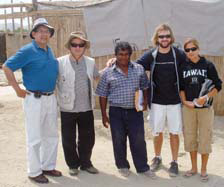Students engineer solutions at home and abroad
September 19th, 2008 | by Crystal Ware | Published in Features, Sept. 2008

Exploring potential projects abroad, UH students Jacob Taylor and Claudia Portocarrero, at right, visit with a local mayor and other volunteers in Peru.
On the Mānoa campus, a group of engineering students is acting both locally and globally. “In just one year, our organization has grown to 25 active members and we have been granted approval for our first international assignment,” reports Chapter President Jacob Tyler.
Nationally 271 Engineers Without Borders chapters partner with international aid organizations on 350 projects in 45 countries, assisting disadvantaged communities improve quality of life through sustainable, environmental and economically sound engineering efforts.
The Mānoa chapter launched summer 2008 joining efforgts with the Sustainable Saunders group(Mālamalama May 2008) to design a water catchment system that collects storm water runoff for irrigating the first floor planter area.
“This project not only prevents erosion and reduce water usage, the recycled barrels will be painted and used as tables and chairs. It is our hope that this will provide a sustainable gathering area where students will be encouraged to take action toward sustainability in their day-to-day lives,” Tyler says.
In fall 2008, the group will focus on La Pita, a small town in Nicaragua, that needs a new bridge, cooking stoves and improved water resources. The town is separated by a large ravine, and the only bridge is extremely dilapidated. The student engineers plan to design and construct a new bridge as part of a broader mission.
“Our critical goal is to teach support to the communities we work with,” Tyler says. “By educating the local workforce we are giving them the tools necessary to build and sustain the community once we leave.”
Future projects include workshops to help engineering and architecture students achieve Leadership in Energy and Environmental Design (LEED) accreditation. Eventually, the group would like to tackle large scale projects, such as construction of a bio-diesel reactor to convert waste oils from campus restaurants into fuel for university vehicles like the one built by the chapter at University of Illinois at Urbana-Champaign.
Meanwhile, students gain hands-on experience in design and construction while learning cultural and ethical awareness.
Read more stories in The Urge to Do Good series:
- Intro: The Urge to Do Good
- Part 1: Students engineer solutions at home and abroad
- Part 2: Peace Corps part of UH experience
- Part 3: Student turns adversity into a medical mission
- Part 4: Library student finds the words to help
- Part 5: More ways UH is making a difference
Tags: College of Engineering, engineering, sustainability, The Urge to Do Good, UH Manoa, Vol. 33 No. 3, volunteering
